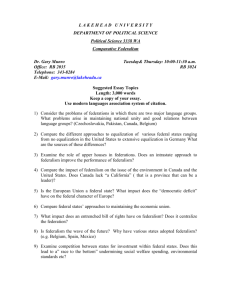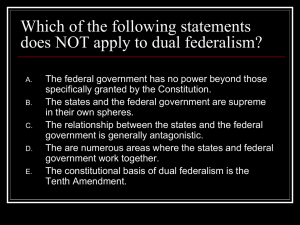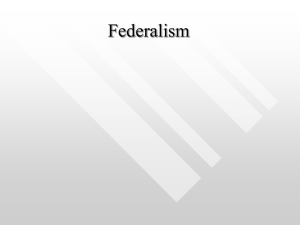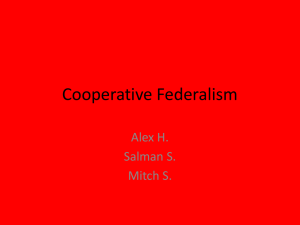Chapter 3 – Federalism
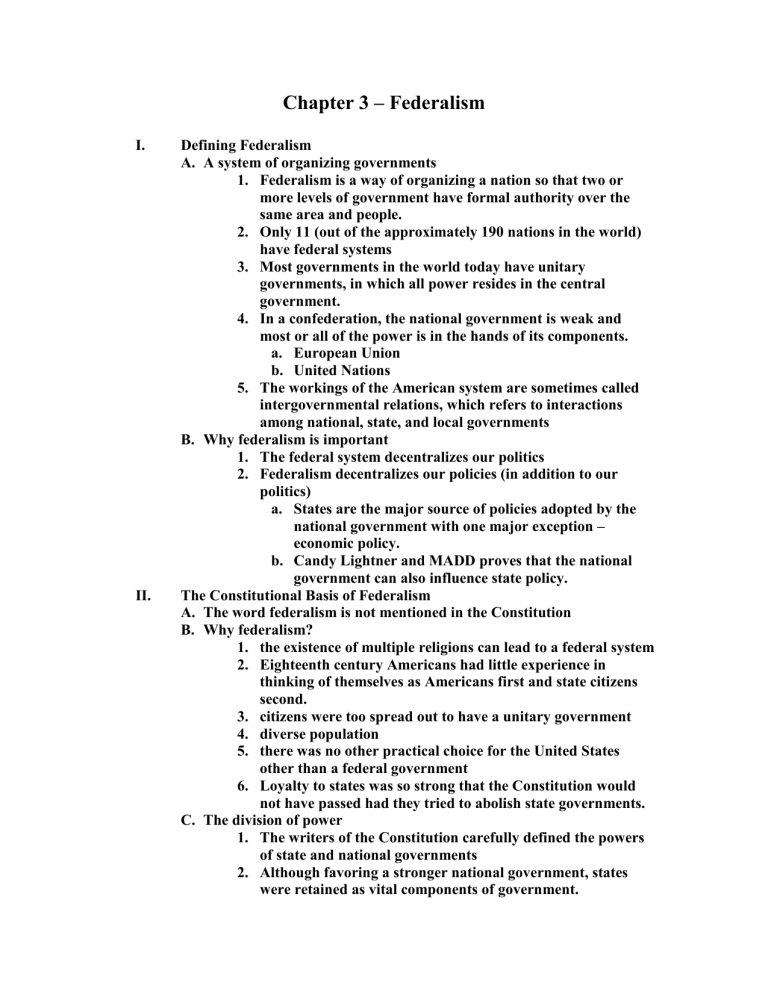
Chapter 3 – Federalism
I.
Defining Federalism
A.
A system of organizing governments
1.
Federalism is a way of organizing a nation so that two or more levels of government have formal authority over the same area and people.
2.
Only 11 (out of the approximately 190 nations in the world) have federal systems
3.
Most governments in the world today have unitary governments, in which all power resides in the central government.
4.
In a confederation, the national government is weak and most or all of the power is in the hands of its components. a.
European Union b.
United Nations
5.
The workings of the American system are sometimes called intergovernmental relations, which refers to interactions among national, state, and local governments
B.
Why federalism is important
1.
The federal system decentralizes our politics
2.
Federalism decentralizes our policies (in addition to our politics) a.
States are the major source of policies adopted by the national government with one major exception – economic policy. b.
Candy Lightner and MADD proves that the national government can also influence state policy.
II.
The Constitutional Basis of Federalism
A.
The word federalism is not mentioned in the Constitution
B.
Why federalism?
1.
the existence of multiple religions can lead to a federal system
2.
Eighteenth century Americans had little experience in thinking of themselves as Americans first and state citizens second.
3.
citizens were too spread out to have a unitary government
4.
diverse population
5.
there was no other practical choice for the United States other than a federal government
6.
Loyalty to states was so strong that the Constitution would not have passed had they tried to abolish state governments.
C.
The division of power
1.
The writers of the Constitution carefully defined the powers of state and national governments
2.
Although favoring a stronger national government, states were retained as vital components of government.
3.
the Supremacy Clause deals with the question of which government should prevail in disputes between the states and the national government; Article VI states that three items are the supreme law of the land: a.
the Constitution b.
Laws of the national government (when consistent with the Constitution) c.
Treaties (which can only be made by the national government)
4.
Judges in every state were specifically bound by the
Constitution.
5.
Questions remain concerning the boundaries of the national government’s powers. a.
The national government can only operate within its appropriate sphere and cannot usurp the states’ powers b.
The Tenth Amendment states that “powers not delegated to the United States by the Constitution, nor prohibited by it to the states, are reserved to the states respectively, or to the people.” – states have certain powers that the national government cannot encroach upon. c.
There have been variations in the Court’s interpretation of the Tenth Amendment.
D.
Establishing national supremacy
1.
Four key events have largely settled the issue of how national and state powers are related: McCulloch v Maryland, the
Supreme Court’s interpretation of the Commerce Clause, the
Civil War, and the civil rights movement
2.
McCulloch v Maryland (1819) – the case that first brought the issue of state versus national power before the Supreme
Court a.
In this case, the Supreme Court ruled that national policies take precedence over state policies: Chief
Justice John Marshall wrote that “the government of the United States, though limited in its power, is supreme within its sphere of action.” b.
The Court also ruled that the Constitution gives
Congress certain implied powers (based on the provision granting Congress the power to “make all laws necessary and proper for carrying into execution the foregoing powers”) that go beyond the enumerated powers that are specifically listed in Article I, Section 8
(chart page 71) i.
The clause that deals with implied powers is also known as the elastic clause or the necessary and proper clause.
ii.
Examples include environmental protection laws, setting up the IRS to collect taxes. iii.
Examples of enumerated powers include the power to tax, coin money, raise an army and a navy, regulate interstate commerce.
3.
The Civil War settled militarily the issue that McCulloch had enunciated constitutionally
4.
The civil rights movement – a century after the Civil War, the policy issue was equality. a.
In 1954, the Supreme Court held that school segregation was unconstitutional (Brown v Board of
Education of Topeka, Kansas) b.
The conflict between the states and the national over equality issues was decided in favor of the national government: throughout the 1960s, the federal government enacted laws and policies to end segregation in schools, housing, public accommodations, voting, and jobs.
5.
Federalism involves more than the relationships between the national government and state and local governments:
Article IV of the Constitution outlines certain obligations that each state has to every other state. a.
Full Faith and Credit – States are required to give full faith and credit to the public acts, records, and civil judicial proceedings of every other state. b.
Extradition – States are required to return a person charged with a crime in another state to that state for trial or imprisonment. c.
Privileges and Immunities of citizens – Citizens of each state receive all the privileges and immunities of any other state in which they happen to be.
III.
Intergovernmental Relations Today
A.
From dual to cooperative federalism
1.
Dual Federalism (“layer cake federalism”) – a form of federalism in which states and the national government each remain supreme within their own spheres.
2.
Cooperative Federalism (“marble cake federalism”) – a form of federalism with mingled responsibilities and blurred distinctions between the levels of government. (ie. National
Defense Education Act, Elementary and Secondary
Education Act, Interstate Highway System)
3.
The American federal system leaned toward dual federalism before the national government began to assert its dominance. Since then, we have moved from dual to cooperative federalism.
4.
In 1995, the Republican Party gained a majority in both houses of Congress for the first time since the 1950s. a.
A major belief of the Republican Party is less government interference in the business of the states. b.
The “Republican Revolution” of 1995 – led by Newt
Gingrich – caused Congress to pass legislation that reduced the overall power of the national government in favor of the states. c.
Since then, a more moderate Congress has reasserted the federal government’s authority.
B.
Fiscal Federalism – the pattern of spending, taxing, and providing grants in the federal system.
1.
Fiscal federalism is the cornerstone of the national government’s relations with state and local governments.
2.
Grants-in-aid are the main instrument the national government uses for both aiding and influencing states and localities. In fact, about 20% of the money spent by state and local governments comes directly from the federal government.
3.
Federal aid to state and local governments amounted to approximately $306 billion in 2001, despite major cutbacks during the Reagan administration. a.
Reagan wanted to make the states and localities more self-sufficient. b.
State and local governments were required to run many federal programs with their own money. c.
This move was not popular with either party or national or state leaders.
C.
There are two major types of federal aid for states and localities: categorical grants and block grants.
1.
Categorical grants (the main source of federal aid) – grants that can be used only for specific purposes or categories. a.
State and local agencies can obtain categorical grants only by applying for them and meeting certain qualifications. b.
Categorical grants come with numerous “strings” (rules and requirements) attached, such as nondiscrimination provisions and punitive cross-over sanctions and crosscutting requirements that reduce or deny federal funds if certain local or state laws are not passed or if federal guidelines are not met. (ie. Drinking age of 21 to receive federal highway funds) c.
There are two types of categorical grants: i.
Project grants – the most common type of categorical grant; awarded on the basis of competitive applications (such as grants to
university professors from the National Science
Foundation) ii.
Formula grants – distributed according to a formula; states and local governments automatically receive funds based on a formula developed from factors such as population (such as Medicare, Aid for Families with Dependent
Children, public housing).
2.
Block grants – used to support broad programs in areas like community development and social services. (These are given almost automatically) a.
In response to complaints about the cumbersome paperwork and restrictive federal requirements attached to categorical grants, Congress established block grants to support broad programs. b.
States have discretion in deciding how to spend the money. c.
The Republican majority in Congress is passing more of this type of federal aid than the Democrats had in the past.
D.
On the whole, federal grant distribution follows the principle of
universalism – that is, something for everybody, even though some money goes where it is really not needed.
E.
There are some occasions when states would prefer not to receive some federal aid – such as when Congress extends a program that is administered by the States and only partly funded by the national government – an under funded mandate. This means that the states have to budget more funds for the project in order to receive federal grant money.
F.
Of even greater concern to states are unfunded mandates. These require state and local governments to spend money to comply with laws such as the Clean Air Act of 1970 and the Americans with
Disabilities Act of 1990 with no financial help from the federal government that enacted the laws. In addition, federal courts create unfunded mandates for state regarding school desegregation, prison construction, and other policies. In 1995, Congress passed a law that would make it more difficult for Congress to pass unfunded mandates
(a product of the Contract with America of the Republican Party).
IV.
Understanding Federalism
A.
By decentralizing the political system, federalism was designed to contribute to the limited form of democracy supported by the founders.
B.
Advantages for democracy
1.
Different levels of government provide more opportunities for participation in politics.
2.
Additional levels of government contribute to democracy by increasing access to government
3.
Two levels of government increase the opportunities for government to be responsive to the demands for policies. (ie. business interests traditionally find their demands received more favorably by state governments than by the national government)
4.
A party that loses strength at the national level can rebuild and groom leaders at the state and local levels.
5.
It is possible for the diversity of opinion within the country to be reflected in different public policies among the different states.
6.
By handling most disputes over policy at the state and local level, federalism reduces decision-making and conflict at the national level.
C.
Disadvantages for democracy
1.
The quality of services like education is heavily dependent on the state in which the service is provided; states differ greatly in the resources they can devote to public services.
2.
Diversity in policy can discourage states from providing services that would otherwise be available because poor people may be attracted from states with lower benefits.
3.
Federalism may have a negative effect on democracy when local interests are able to impede national majority support of certain policies.
4.
The vast number of local governments (over 87,000 in the
US) makes it difficult for many Americans to know which government is responsible for certain functions.
5.
Voter turnout is traditionally lower in state elections than it is in national elections, probably because of a lack of media coverage.
D.
Federalism and the growth of the national government
1.
The national government took a direct interest in economic affairs from the very founding of the republic [see Ch. 2]
2.
As the United States changed from an agricultural to an industrial nation, new problems arose and with them new demands for governmental action.
3.
The United States moved from a system of dual federalism to one of cooperative federalism in which the national and state governments share responsibility for public policies.
4.
The strength of the national government has grown over that of the states because most problems and policies today require the authority and resources of the national government.
E.
Federalism and the scope of the national government
1.
The national government’s share of expenditures has grown rapidly since 1929; today it spends about 20% of the GDP, while state and local governments spend about 9% today.
2.
The growth of the national government has not supplanted the states. In fact, the state governments carry out most of the functions that they always have, while the national government has added new responsibilities.



